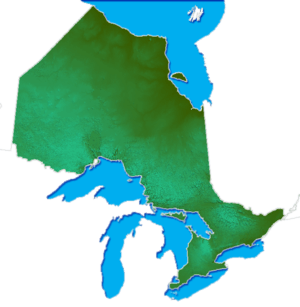Fort George, Ontario
|
| |
| Established | 1965 |
|---|---|
| Location | 51 Queen's Parade, Niagara-on-the-Lake, Ontario, Canada |
| Type | National Historic Site |
| Website | www.pc.gc.ca/lhn-nhs/on/fortgeorge/index_E.asp |
Fort George National Historic Site is a historic military structure at Niagara-on-the-Lake, Ontario, that was the scene of several battles during the War of 1812. The fort consists of earthworks and palisades, along with internal structures, including an officer's quarters, blockhouses to accommodate other ranks and their families, and a stone powder magazine, which is the only original building on the site. Opposite the fort, across the Niagara River, stands Fort Niagara in New York, which can be seen from Fort George's ramparts.[1]
Fort George was built by the British Army after Jay's Treaty (1796) required Britain to withdraw from Fort Niagara. The new fort was completed in 1802 and became the headquarters for the British Army and the local militia. Fort George was captured by U.S. forces in May 1813 at the Battle of Fort George. The American Army used the fort as a base to invade Upper Canada, but were repelled at the Battles of Stoney Creek and Beaver Dams. The fort was retaken by the British Army in December of that year after U.S. forces abandoned the British side of the river.
The fortification was used by the Canadian Army as a military training base during the First World War and through the Second World War under the name Camp Niagara. The grounds were eventually abandoned by the military in 1965.
The site is now a National Historic Site of Canada, maintained by Parks Canada with operating hours varying as appropriate to the season.[2] The staff maintains the image of the fort as it was during the early 19th century, with period costumes, exhibits, and displays of that time. They train summer students in the infantry tactics and firing drills of the 41st regiment from the War of 1812. They also have the 41st Fife and Drum Corps which provides an example of how the fife and drums were used.
Reenactors from both the United States and Canada meet on and near the grounds of the fort and reenact the battle that took place in May of 1813. This has taken place since 1984 and has grown from a small group of 300 "troops" to over 1800.
The grounds surrounding the fort and the commons adjacent to the fort provided the site for the 8th World Scout Jamboree held in August 1955.
Fort George National Historic Site is one of a handful of sites managed under the administrative name "Niagara National Historic Sites" by Parks Canada, within the National Park System.
The television show The Girly Ghosthunters paid a visit to the fort to investigate any paranormal activity that was allegedly documented there. The episode was shown as the second, of thirteen, episodes of the show in 2005.
Interpretation and reenactment
The interpreters and infantry members are dressed in period dress and uniforms. Infantry soldiers, officers and fifes and drums are dressed representing the 41st Regiment of Foot.
The reproduction British 8" mortars are a unique pattern found nowhere else. RMW Sr. Curator Ret. Parks Canada
Affiliations
The museum is affiliated with: Canadian Museums Association, Canadian Heritage Information Network, and Virtual Museum of Canada and also the Upper Canada heritage centre. It has been a historical site since the mid 1900s.
See also
- Chronology of the War of 1812
- War of 1812 Campaigns
- List of forts
- War of 1812
- Upper Canada
- Fort Mississauga National Historic Site
- Fort Niagara
- Fort Schlosser
References
- ↑ "Fort George National Historic Site of Canada". www.pc.gc.ca. 2012-03-15. Retrieved 2013-09-24.
- ↑ Canada, Parks Canada Agency, Government of. "Parks Canada - Fort George National Historic Site - Hours of Operation". www.pc.gc.ca. Retrieved 2016-11-04.
| Wikimedia Commons has media related to Fort George National Historic Site. |
External links
- Official website
- Ghost Tours of Niagara at Fort George
- Friends of Fort George Charitable Organization
- The Capture of Fort George 1813
- The Scout Brigade of Fort George
- 8th World Jamboree
Coordinates: 43°15′03″N 79°03′40″W / 43.25083°N 79.06111°W
